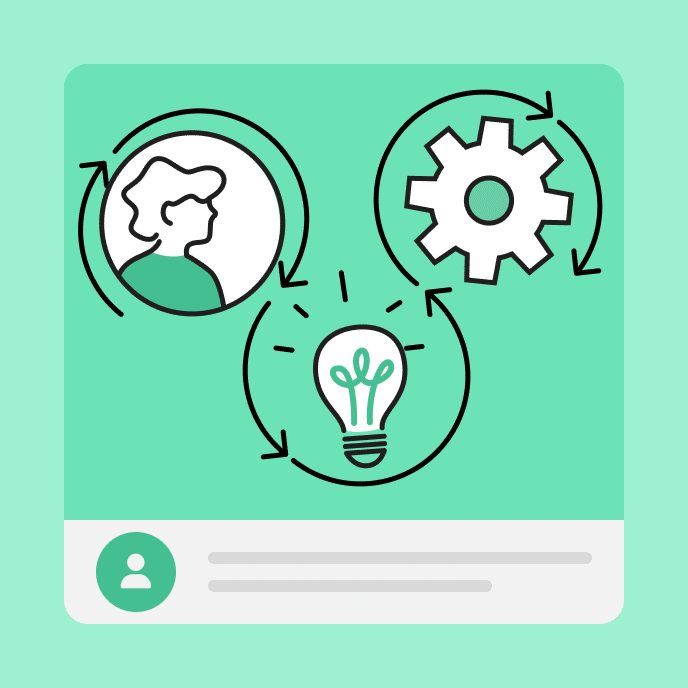6 Sales Enablement Training Strategies for the Driven Sales Pro
Learn the similarities between sales pros and learning pros, explore proven L&D strategies to boost productivity, and discover the tools your sales reps need.

Are you a trainer? If you’re in sales enablement, the answer is yes
As a sales enablement pro, you design and deliver step-by-step workshops, sales playbooks, and special certifications. You create and manage sales content like pitch decks, battlecards, and presentations aligned to the buyer’s journey. You analyze sales methodologies, identify skill gaps, and track key metrics like ramp time, win rates, and sales cycle length.
In other words, you’re an educator, a guide, a trainer—and while you may not be called a training specialist, you’re certainly already thinking like one. Add to your repertoire the tools and best practices every training pro depends on, and your sales enablement strategy will see the returns in performance, productivity, and revenue you’ve been chasing.
In this post, learn the similarities between sales pros and training pros, explore learning and development best practices to help sales enablement teams drive true business value, and discover the training tools you need to make it happen.
Key Takeaways
- While sales enablement and training pros both prioritize efficiency, productivity, and engagement, sales professionals don’t often think of themselves as trainers.
- Workplace training elements like content management, training initiatives, ongoing support, and engagement metrics translate directly to core elements of sales enablement.
- Common learning and development best practices and learning methods like microlearning, mobile learning, and gamification can drive sales enablement metrics beyond their current ceiling.
- Dynamic content and learning management systems can break down the productivity barriers that sales reps face in their daily workflow.
Sales pros vs. training pros: the core elements
Sales enablement professionals and training professionals share many common responsibilities in their daily workflow. Let’s explore four core elements of sales enablement that connect to the wider world of workplace training.
Content management
According to a recent Salesforce study, only 28 percent of a sales rep’s time is spent selling. The remainder of that time? Prospecting, preparing presentations, meeting with clients, and tracking down the necessary content to make the sale. Effective content management can reduce the time spent searching for the right material, increasing productivity and leaving more time for sales.
To a training pro, content management is paramount to the success of their learners. They rely on robust learning management systems (LMS) to organize, distribute, and track learning content to individual and grouped learners. When it comes to content delivery, timeliness and relevancy are key, providing the information learners need exactly where and when they need them.
Onboarding and sales training
Integrating new reps into the fast-paced rollercoaster that is sales can be a delicate dance between pushing them too fast and holding them back for too long. The former risks creating unprepared and overwhelmed reps, leading to early turnover, and the latter risks slowing time-to-productivity, decreasing the chances of a positive return on investment.
To a training pro, an effective onboarding process is the first major line of defense against everything a sales enablement leader fears: low productivity, unorganized sales teams, siloed departments, and a lack of adaptability. While onboarding sets the tone, it’s continuous learning in the form of soft skills training, sales training, and technical skills training—topics any training pro knows well—that can elevate sales enablement to a whole new level.
Sales coaching and feedback
Any good leader knows that ongoing coaching and support is essential to building an effective team—in sports, education, and on the job. Veterans and rookies alike need it to sustain the momentum gathered after initial training and onboarding. As a sales pro, you’ve likely implemented highly personalized coaching that speaks to the strengths, weaknesses, and development needs of each unique rep.
To a training pro, ongoing coaching and personalized feedback helps employees recognize their value to the company—a company that wants their employees to experience consistent professional growth. It also helps cultivate a continuous learning culture where new challenges are met with new solutions, and it helps to combat the forgetting curve—the astonishingly quick rate at which we forget new information.
Buyer engagement
At its core, buyer engagement is about creating meaningful interactions between sales teams and potential customers. To do so, reps need the right tools, resources, training, and insights. When a sales team’s toolbox has prepared them to meet customer needs and address common pain points effectively, a trusting relationship is formed, strengthening the bond between customer and rep.
To a training pro, engagement for all involved parties is a must. Their daily workflow is aimed at engaging the learner—whether that’s a new customer service rep training for difficult conversations, a customer going through product training, or a veteran sales rep taking soft skills training to help form stronger bonds with clients. Regardless, meaningful interactions are top priority for both sales pros and training pros.
Benefits of sales enablement training
Sales leaders agree that boosting productivity and upskilling through sales training are two of the most important developing areas of sales enablement driving tangible revenue growth. Similarly, any training pro will point to workplace training initiatives as the catalyst for increased productivity—beginning with foundational skills, progressing to real-world application, and providing ongoing support.
Effective sales enablement programs pull the best pages from sales leader playbooks and training professional best practices, producing the following benefits:
- Increased productivity. Both sales leaders and training professionals focus on streamlining the processes learners use to access relevant material, leaving more time for revenue-generating tasks like selling.
- Improved customer experience. Effective sales training means customers enjoy up-to-date, tailored, and efficient conversations with knowledgeable sales reps, leading to higher customer loyalty and increased revenue.
- Faster onboarding. Faster ramp time through effective onboarding accelerates time-to-productivity for new reps, proving positive training ROI.
- Stronger cross-functional alignment. Every good training pro knows the importance of including key organizational stakeholders in the development of an effective training program. For sales enablement teams, that means collaborating with marketing teams and other subject matter experts to cultivate a unified approach to sales.
- Adaptability. Training professionals embed ongoing learning and support after initial training to ensure seamless adaptation to changing business goals and evolving learner needs. Similarly, a sales rep’s ability to adapt to changing market conditions and evolving product features depends on timely and relevant continuous learning opportunities.
Now that we’ve covered the benefits of combining sales leader and training pro knowledge, let’s explore sales enablement training strategies from the lens of a workplace training professional.
6 sales enablement strategies developed by training pros
Both sales leaders and training managers will agree that boosting employee productivity is a top organizational goal they’re expected to contribute to consistently. To do so, training professionals have developed a number of best practices—regardless of the type of training and intended audience—that sales leaders can leverage.
To a learning pro, employee engagement is everything, directly contributing to higher profitability and productivity, and every sales leader knows that reps fully immersed in sales culture perform better. Here’s how to make it happen:
1. Microlearning and mobile learning
Microlearing—the practice of distributing learning content in short, digestible chunks to increase knowledge retention—is every learning pro’s best friend. Microlearning courses typically focus on a single topic, like how to spot phishing scams or basic product knowledge training, preventing information overload.
Why it works for sales enablement: Paired with mobile learning, a form of just-in-time training that delivers content to any device—particularly helpful for on-the-go sales reps—microlearning modules provide learning exactly when it’s needed. Prior to a prospective client interaction, sales reps can easily review product information, digital sales battlecards, or active listening skills.
2. Align learning to business goals
Just as students demand to know why they’re learning something, so do employees. Providing clear learning objectives that align with organizational business goals can be the motivation employees need to engage with learning content. From a learning professional standpoint, aligning objectives with business goals ensures that training initiatives are built to contribute to measurable outcomes like productivity.
Why it works for sales enablement: Imagine your organization has launched an initiative to increase customer satisfaction scores (CSAT) by 15 percent by the end of Q3. As a sales leader, you might implement a sales enablement course that uses branching scenarios to help reps practice handling difficult client conversations. This will cut down on customer frustration, leading to higher CSAT scores.
3. Personalized learning and role-based paths
Training that aligns with an employee’s unique set of strengths, weaknesses, and aspirations will be inherently more engaging, motivating them to make the most out of learning opportunities. Role-based learning pathways provide employees with relevant, timely learning content, providing ample opportunities to upskill and even reskill for those looking to move upward or laterally into other roles.
Why it works for sales enablement: Even within the same sales team, reps have different needs, preferences, and ambitions. While one may benefit from further training on product positioning, another may need help developing better customer interaction skills. Furthermore, reps looking to advance within the sales enablement structure may be interested in courses on how to manage a sales team.
4. Social learning and collaborative environments
Social learning in collaborative environments promotes knowledge sharing, critical thinking skills, and a stronger sense of belonging. Learning pros know this can happen both synchronously—via in-person role-playing and other group-based activities—and asynchronously through virtual discussion forums and mentor/mentee feedback loops.
Why it works for sales enablement: The sales cycle can be frustratingly inconsistent. Prospective clients—and even loyal customers—have dynamic needs, making it all the more important for sales reps to learn, imitate, and apply knowledge and skills from their peers and mentors. Sometimes, unique situations arise without precedence. That’s when collaborative learning shines, providing a space for cross-functional teams to contribute to learning.
5. Data analytics and continuous learning
Understanding the impact of training initiatives on productivity and revenue growth depends on the careful and intentional analysis of key performance indicators (KPIs). To measure critical KPIs, many organizations rely on learner progress and engagement tracking tools that are built-in to most learning management systems (LMS). These data analytics tools make it easier to align learning to business goals and create relevant, role-based training pathways.
Why it works for sales enablement: Measuring win rate, average sales cycle, conversion rate, average response time, and other sales metrics allows sales leaders to be more efficient with ongoing support and continuous learning initiatives. Many sales departments use these metrics to drive weekly 1:1s, call reviews, and other coaching or mentoring sessions, using real data to motivate, engage, and recognize employees.
Bonus training tip: Paired with a microlearning course on growth mindset, data analytics can be just what you need to elevate your reps.
6. Gamification and recognition
Gamified training methods—which incorporate gaming elements like badges, rewards, weekly challenges, and time constraints—help to inject healthy competition and drive employee focus. The incentives offered—bonuses, PTO, and plain old public recognition—can do wonders for employee motivation and retention.
Why it works for sales enablement: It’s no secret that sales reps are a competitive bunch, but adding a live leaderboard to the mix? That can drive the extra motivation needed when things aren’t moving in the right direction. Tie incentives to measurable KPIs, and be sure to include team-based incentives rather than individual incentives, especially if a collaborative team culture is important to your organization.
Now that we’ve covered learning and development strategies that sales leaders can leverage, let’s explore the tools you need to drive those strategies.
Leverage technology to streamline workflow, boost productivity
Many sales leaders cite an overwhelming tech stack as the biggest productivity barrier for their sales reps. Content is disorganized, training modules are spread across multiple platforms, and important stakeholder feedback is left unread. To ensure you’re able to put sales enablement strategies into action, you and your reps need a comprehensive, centralized tool to streamline daily workflow.
For the best sales training solutions, turn to the Articulate 360 platform, which allows you to:
- Create engaging sales training material like battlecards and client interaction skills
- Access a vast library of customizable course templates and rich multimedia assets
- Invite colleagues and subject matter experts to review and edit sales materials
- Deliver just-in-time learning to any device, exactly when and where reps need it
Wrapped into a single dynamic platform for both back-end users and front-end learners, the Articulate 360 platform is your solution to boost sales performance and productivity.
Lean into training pro knowledge
Implement professional training strategies to get the most out of your sales enablement programs. Organize your sales content, level up your onboarding program, provide ongoing coaching, and engage your sales reps with meaningful learning. Utilize microlearning and mobile learning techniques to improve knowledge retention and align learning with business goals to drive real results.
Interested in learning more about the intersection of sales enablement and training? Find out how OneVision Resources delivers white-glove sales enablement training with Articulate 360. Ready to break down daily workflow barriers and boost productivity? Start a free trial of the Articulate 360 platform and take your sales enablement strategies to the next level today.
You may also like

What Is Cognitive Learning? And Why Does It Matter?
Explore cognitive learning, an approach that boosts comprehension, confidence, and real-world problem-solving for employees and learners alike.

